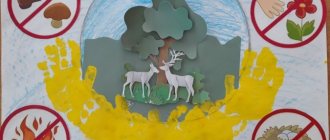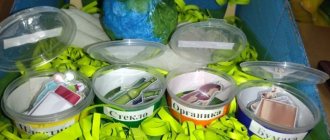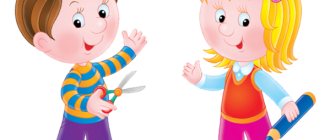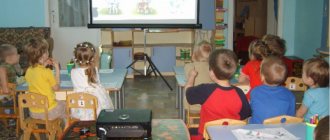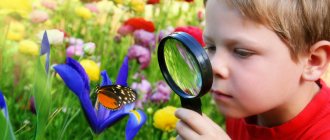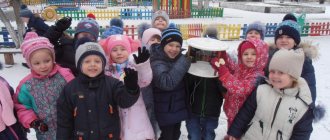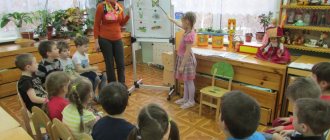Middle group. Junior preschool age. Children 4 - 5 years old
Environmental project "Ecolyats - preschool children" in the middle group Environmental project " Ecolyats - preschool children "
Middle group Justification of the problem.
The presence of global environmental environmental problems is a serious threat to all humanity in the modern world.
Today, the main task for people should be the preservation... Environmental social and educational project in the middle group (from 4 to 5 years old) “Eco-preschool children” Relevance of the Project One of the directions for the development of the state and the unification of a multinational society is the patriotic education of the younger generation. This is one of the priority areas in the Russian education system, contributing to the formation of...
Environmental education project “Journey to the world of insects”
Project passport
Project type: Content - educational, research, creative, gaming. By the number of participants - group By the nature of contacts - within the framework of the GBDOU By the nature of the child’s participation in the project - from the inception of the idea to the receipt of results
Implementation period: short-term (2 weeks: from April 28 to May 15, 2014)
Project participants: • Group teachers: Zavyalova N.A., teacher I category Beschastnova O.O., teacher • Music director Stratienko N.V. • Children of middle group No. 6 • Parents
Relevance of the project: The problem of environmental education of a preschooler is one of the fundamental problems of the theory of education and is of paramount importance for educational work. All outstanding thinkers and teachers of the past attached great importance to nature as a means of raising children: Ya. A. Komensky saw in nature a source of knowledge, a means for the development of the mind, feelings and will. K. D. Ushinsky was in favor of “leading children into nature” in order to tell them everything that was accessible and useful for their mental and verbal development. In modern conditions, when the scope of educational influence is significantly expanding, the problem of environmental education of preschool children becomes particularly acute and relevant. With the adoption of the laws of the Russian Federation “On Environmental Protection” and “On Education” (1996), the prerequisites for the legal framework were created for the formation of a system of environmental education for the population. “Decree of the President of the Russian Federation on environmental protection and sustainable development” (1992), taking into account the Declaration of the UN Conference on Environment and Development, signed by Russia, environmental education is gradually becoming an important area among the priority state problems. These documents imply the creation in the regions of the country of a system of continuous environmental education, the first link of which is preschool. Therefore, environmental education of the younger generation is one of the most important, urgent tasks of the entire public education system, which is implemented at all its levels.
Preschool age is the most favorable period for a child’s emotional interaction with nature. This entails the task of developing a responsible attitude towards nature in children. After all, it is children of this age who are characterized by a unique unity of knowledge and experiences, which allow us to talk about the possibility of forming in them reliable foundations for a responsible attitude towards nature. And the earlier work on environmental education of children begins, the greater its pedagogical effectiveness will be. At the same time, all forms and types of children’s activities should be closely interconnected. The interests of children and their desires are taken into account here; ionic and innovative forms and methods of work.
Sometimes children break branches of trees and bushes, destroy bird nests and torture animals. This is explained by the fact that their interest in the surrounding nature was not maintained in time and, on the basis of this healthy interest, they were not introduced to the life of plants and animals. Children cannot independently explain many natural phenomena that interest them, and therefore this is the responsibility of adults.
* In modern conditions, the problem of environmental education of preschool children becomes particularly acute and relevant.
* Most modern children rarely communicate with nature. Environmental education begins with familiarization with the objects of the immediate environment that the child encounters every day. In any village or city, you can find natural objects interesting to observe: trees, grass, insects, birds. Practical and research activities in natural conditions play a huge role in the environmental education of preschool children. They can be studied in the process of design and research activities. Indeed, in the process of childhood research, the child acquires specific cognitive skills: he learns to observe, reason, plan work, learns to predict the result, experiment, compare, analyze, draw conclusions and generalizations, in a word, develops cognitive abilities. Therefore, children are given an additional opportunity to get involved in research work as the leading way of understanding the world around them.
While walking, the children saw a beetle. The guys' reaction was mixed. Some children expressed joy and genuine interest, others were scared. There were also guys who suggested destroying it. Opinions were divided. During the conversation, it became clear that preschool children’s knowledge about insects is very poor. So the problem arose: “Are insects necessary? Do they bring benefit or harm? Children’s participation in the project will allow them to form ideas about insects, their benefits or harm; develop creativity and search activity
Project goal: To create conditions for the development of children’s cognitive and creative abilities in the process of implementing the educational project “Insects”.
Project objectives: • To form a realistic idea of the nature around us, the desire to become a friend of nature, to preserve and protect it. • To form in children elementary ideas about insects (butterfly, ant, beetle, bee, grasshopper), their structure, and methods of movement. • Foster a caring attitude towards living things. • Develop emotional responsiveness • Build research skills.
Expected result of the project: • Children will develop a pronounced interest in objects of nature - insects. • The ability to distinguish and name insects: butterfly, ant, beetle, bee, grasshopper. • Knowledge of the benefits or harm that insects bring to people and plants. • Respect for nature, children's desire to behave correctly in relation to insects. • Forming in children a desire to explore natural objects, the ability to draw conclusions and establish cause-and-effect relationships. • Forming the idea that insects cannot be divided into useful and harmful, and even more so, be guided by this in your actions towards them.
Form of the final event of the project: Musical and ecological leisure “Man and nature make friends”
Cooperation with the family: • Consultations “How to instill a love of nature”, “First aid for insect bites”. • Coming up with riddle drawings about insects
Project products: • Presentation for children “Our neighbors are insects” (teacher Zavyalova N.A.) • Presentation for children “Insects in riddles” (teacher Zavyalova N.A.) • Presentation for children “Nature in music (Insects) "(music director Stratienko N.V.) • Butterfly (applique; children) • Ladybug (modeling; children) • Bee (paper construction; children) • Butterfly (drawing; children) • project portfolio (teacher Zavyalova N. A)
Expected result of the project: • For children:—Children’s caring attitude towards nature, in particular towards insects. — Development of cognitive activity and curiosity. • For teachers:— Development of children's communication skills and ability to work in a team. — Creating conditions for children to demonstrate creativity and imagination. — Expanding children’s horizons through reading fiction, becoming familiar with proverbs, learning poetry — Development of musical and creative abilities. • For parents:— Visiting the Zoological Museum with children. — Joint reading of fiction about insects — Involvement in cooperation to create a subject-development environment in kindergarten.
The project consists of three stages:
Stage I – preparatory:
• Project development • Diagnosis of children's environmental knowledge about insects • Selection of literary works about insects • Making a presentation “Our neighbors are insects” • Selection of methodological literature and illustrated material on the topic. • Selection of materials, toys and attributes for play activities • Selection of musical works on the topic • Drawing up a plan for the main stage. • Determination of goals and objectives of project activities.
Stage II – main (project implementation):
• Informative conversations on the topic using presentations. • Research activities (observing insects on a walk), examining insect body parts with a magnifying glass. • Reading fiction: G. H. Andersen “Thumbelina”, K. Chukovsky “Tsokotukha Fly”; V. Suteev “Under the Mushroom”, G. Skrebitsky “Happy Bug”, Krylov’s fable “Dragonfly and Ant” • Learning counting rhymes, nursery rhymes and poems by T. Kulakova; Guessing riddles on the topic. • Finger gymnastics “Beetle, dragonfly, wasps”, “Ladybugs”, • Listening to an audio recording of N. Rimsky-Korsakov “Flight of the Bumblebee”, P. Tchaikovsky “Waltz of the Flowers”; Maykapar “Moth”, “Waltz”; D. Zhuchenko “Two caterpillars are talking” • Learning songs: Y. Zheteneeva “Ladybugs”; I. Kushnikova “How beautiful the world is”; E. Gomonova “Kindness”; game with singing by V. Zolotareva “Bug”; • Dance improvisation “In the meadow” to the music of Maikapar “Rosinki”; I. Bach “Joke” • Dramatization of V. Ivannikov’s song “The mother taught the children bees”; • Watching the cartoons “Dragonfly and the Ant”, “Maya the Bee”, “Ant’s Journey”, “Under the Mushroom”. • Didactic games: “Treat an insect”, “In the meadow”, “How to say correctly?” "Pick a flower." • Educational games: speech with the movement “Bug” • S/R games, free activity of children (playing out Krylov’s fable “The Dragonfly and the Ant”) • Outdoor games: “Bear and Bees”, “Day and Night” • Creative and productive activities ( drawing, applique, modeling)
Creating conditions for independent activity of children, creating a subject-development environment
Interaction with family • Consultations “How to instill a love of nature”, “First aid for insect bites”
Stage III – Final
• Design of an exhibition of children's works. • Conducting musical and ecological leisure “Man and nature make friends” with the invitation of children from another group. • Design of a project portfolio • Creation of a project presentation.
Appendix • Photo montage • Counting books, nursery rhymes, riddles about insects • Didactic games • Diagnosis of ecological knowledge about insects for middle group children • Summaries of joint educational activities with children to get acquainted with nature • Scenario for musical leisure
Educational conversations:
Purpose: - To familiarize children with the names and body parts of insects, their habitats; a general term for insects. — introduce children to the ways of feeding, the way of life of insects, how insects protect themselves from enemies, what benefits or harm they bring, and the importance of insects for the lives of other inhabitants of nature.
DICTIONARY (lexical minimum)
Nouns: Insect, beetle, butterfly, bee, ant, ladybug, fly, head, mustache, wings, paws, honey, meadow, garden, flowers, leaves, grass, pond.
Adjectives: Beautiful, big, small, light, striped, useful, harmful, black, red, yellow, colorful.
Verbs: fly, crawl, sit, spin, eat, drink, catch, bite.
Adverbs: High, low, far, close.
Riddles about insects
In a green tailcoat, the maestro flies over the meadow in bloom. He is the pride of the local orchestra and the best high jumper. (Grasshopper)
They look a little small, of course, but they drag everything they can into the house. Restless guys - Their whole life is connected with work. (Ants)
A blue airplane sat on a white dandelion. (Dragonfly)
I don’t buzz when I sit, I don’t buzz when I walk, I don’t buzz when I work, I buzz when I spin. (Bug)
It flutters and dances over the flower, waving its patterned fan. (Butterfly)
In the morning I'm buzzing, I'm waking up the flowers. I'm circling, buzzing, and driving honey (Bee)
All four petals of the flower were moving, I wanted to pick it - He fluttered and flew away. (Butterfly)
Nursery rhymes:
- Beetle, beetle, where is your house? - Filya the farrier rode under a birch leaf and trampled my house.
- Bee-bee, Golden withers, Fly to the meadow, Bring us some honey.
Counter:
There lived a cricket behind the stove, Heels checked and checked, But the heel broke - And behind the stove there was silence
Diagnostics of ecological knowledge about insects of middle group children
Response evaluation criteria:
1 point – if there is no answer or the child finds it difficult to answer the question, gets confused. 2 points – the child has a certain amount of knowledge, but answers using leading questions. 3 points – the child answers independently and can formulate conclusions.
For diagnostics, the lotto game “Insects” is used.
Diagnostics of ecological knowledge about insects of middle group children
Didactic games
• “Treat an insect” Goal: to expand children’s vocabulary with words denoting the names of insects. Form categories of nouns in the dative case. Material: Medallions (pictures) depicting insects, toy plates with treats: flowers, cabbage, honey, jam; phonogram.
Progress of the game
The teacher invites the children to look at pictures of insects and name them. Then he asks to show which insect likes to eat what (for example: a butterfly likes to eat nectar, a caterpillar likes to eat cabbage)
Next, the teacher invites the children to turn into insects, and while the music is playing, perform movements characteristic of the selected insect. When the music ends, the adult asks: “Who will I give flowers to? (To the butterfly).Who will I give honey to? (To a Bee)"
• “In the meadow” Purpose: To teach children to independently change verbs by numbers and persons.
Progress of the game
The teacher tells the children: “I will recite a poem, and you help me - add the right word.”
For example: Butterflies in the sky…. (fly), Wings... (flapping), They amuse us. I don’t... (fly) On a jump rope I... (jump) Hopscotch... (play) If I just want, Like a grasshopper... (jump) Sitting in the grass... (grasshopper) Green cucumberOnly the wind rustled Our grasshopper... (flew away) Jumping and ... (jumps) Never ... (cries)
• “How to say it correctly” Purpose: To teach children to form the plural of verbs. Material: Ball.
Progress of the game
Children stand in a circle. The teacher throws the ball to the child and asks him to finish the phrase he started.
For example: - A butterfly flies, and butterflies... (fly) - A beetle crawls, and beetles... (crawl) - A bee collects nectar, and bees... (collect) nectar. - The grasshopper jumps, and the grasshoppers... (jump)
• “Collect a flower”
Goal: develop logical thinking; consolidate knowledge of the concept of “insects”
Progress of the game
The teacher says that she has a very unusual flower, which consists of separate petals. There are drawings on the petals. Invites the children to collect a flower. Warns that only smart, attentive children can assemble it.
Each child chooses a round card - the middle of the flower. The game is played on the lotto principle. Each participant collects a flower, the petals of which depict objects related to one concept (flowers, insects, clothes, wild animals, etc.)
Speech with the movement "BEETLE"
I found myself a beetle (Children stretch their arms forward, as if showing a beetle) On a large daisy. I don’t want to hold it in my hands, (They pretend to put it in my pocket) Let it sit in my pocket. Oh, I fell, my beetle fell (bend down) My nose got dirty with dust. (show nose) My cockchafer flew away (waving hands) Wings buzzed.
References used: 1. L.V. Lebedeva, I.V. Kozina
Authors: Zavyalova Natalya Aleksandrovna, teacher of the first category, Stratienko Natalia Viktorovna, music director of the first category, State budgetary preschool educational institution kindergarten No. 69 of the Vyborg district of St. Petersburg, Russia
The article is published in the author's edition
Long-term plan for the club “The Unexplored is Nearby”
October
Parent meeting on the topic : Let's experiment, learn, create!
Contents : Informing parents that the main advantage of the experimentation method is that it gives children real ideas about the various aspects of the object being studied, about its relationships with other objects and with the environment. During the experiment, the child’s memory is enriched, his thought processes are activated, since the need constantly arises to perform operations of analysis and synthesis, comparison and classification, and generalization.
January
Consultation “Development of observation and curiosity of a preschool child through experimental games at home.” Contents: Informing parents on how to properly ensure the full environmental education of a child of middle preschool age. Continue to introduce games to study the properties of objects and inanimate phenomena that will be used by parents at home.
April
Open game-activity “Journey to the Sand Fairy.”
The relevance of the development and implementation of a pedagogical project
From birth, children are surrounded by various phenomena of inanimate nature: on a summer day they see the sun and feel the warm wind; on a winter evening they look in surprise at the moon, the dark sky filled with stars, feel the frost pinching their cheeks... They collect stones, draw on the asphalt with chalk, play with sand and water - objects and phenomena of inanimate nature are part of their life activity, are objects of observation and play. This circumstance makes it possible to systematically and purposefully familiarize preschoolers with the phenomena of inanimate nature. Moreover, it is simply necessary.
In nature, everything is interconnected: plants, animals, soil, rivers, air, etc. are in inextricable unity - living nature cannot do without inanimate nature. The plant exists only because it penetrates the ground with its roots and absorbs moisture and nutrients from it, stretches its stem upward, and turns its leaves toward the sun, absorbing its light and heat. The plant needs air, moisture and warmth; in such favorable conditions it feels good: it grows, blooms, bears fruit and pleases the human eye.
The same can be said about animals: they, like plants, have vital needs, many of which can be satisfied only with the help of inanimate nature. Thus, animals, as part of living nature, have their own special relationships with inanimate nature.
Humans have an even stronger connection with inanimate nature than plants and animals. People need fresh air, for life and farming they need water, but not any water, only clean water - natural or specially purified. Humanity has reached such heights in the development of civilization because it has learned to use natural resources: extract coal, oil, ore, use clay and sand in construction, making household items...
Thus, all phenomena of inanimate nature that surround a preschooler are the subject of a unified system of environmental education.
Understanding the importance of search activity in the development of children’s cognitive activity and their intellectual abilities, I chose children’s experimentation as one of the types of activity. The proverb says: “Tell me and I’ll forget, show me and I’ll remember, let me try and I’ll understand.” Everything is assimilated firmly and for a long time when the child hears, sees and does it himself. This is the basis for the active introduction of children's experimentation into the practice of preschool institutions.
Plan for working with children
September
Project development. Selection of method, literature.
October
Topic: “What kind of water?”
Purpose: To identify the properties of water: transparent, odorless, flows, some substances dissolve in it, has weight, has no color and odor.
Expected result : Children will learn the properties of water such as: transparent, flowing, is a solvent, has no color and odor, and has weight.
Topic: What's in the package?
Goal: Detect air in the surrounding space.
Expected result : Children learn that air occupies all the surrounding space.
November
Topic : Light - heavy.
Purpose: to introduce that objects can be light and heavy. Learn to determine the weight of objects and group objects by weight (light - heavy). Expected result : They will learn to determine the weight of objects and group objects by weight (light - heavy).
Topic: We are magicians.
Goal: Identify objects that interact with a magnet. Expected result : They will become familiar with the properties of a magnet and objects that interact with it.
December
Topic: How to warm your hands?
Goal: Identify the conditions under which objects can warm up (friction, movement; heat conservation). Expected result : They will learn to heat objects using friction, movement and identify the conditions for maintaining heat.
January
Topic: Glass, its qualities and properties.
Goal: Recognize objects made of glass; determine its qualities (surface structure, thickness, transparency) and properties (fragility, melting, thermal conductivity).
Expected result : Get acquainted with glass and its properties. Learn to identify its qualities.
February
Topic: Metal, its qualities and properties.
Goal: Recognize objects made of metal, determine its qualitative characteristics (surface structure, color) and properties (thermal conductivity, malleability, metallic luster).
Expected result : Get acquainted with metal and its properties. Learn to identify its qualities.
Topic: Magic mitten.
Goal : Find out the ability of a magnet to attract certain objects. Expected result : consolidate the properties of a magnet and identify with which objects it interacts.
March
Topic: Rubber, its qualities and properties. Goal: To recognize things made from rubber, to determine its qualities (surface structure, thickness) and properties (density, elasticity, elasticity). Expected result : Get acquainted with rubber and its properties. Learn to identify its qualities.
Topic: What do birds use to build their nests?
Purpose: To identify some features of the lifestyle of birds in the spring. Expected result : They will learn some features of the way of life of birds in the spring.
April
Topic: Plastic, its qualities and properties.
Goal: To recognize things made of plastic, to determine its qualities (surface structure, thickness, color) and properties (density, flexibility, melting, thermal conductivity). Expected result : Get acquainted with plastic and its properties. Learn to identify its qualities.
Topic: Water transparency.
Goal: To generalize “clean water is transparent”, “dirty water is opaque”. Expected result : Get acquainted with the property of water “transparency”, learn to identify clear water.
May
Topic: "Paper lumps."
Goal: To introduce children to a new property of paper - rolling. The teacher teaches children to make lumps of paper, and then use them as a collective applique. Expected result : They will become familiar with a new property of paper - rolling. The teacher teaches children to make lumps out of paper, and then from them into a collective applique.
Forms of working with children
Based on conceptual approaches and taking into account the characteristics of children, we have developed and tested a series of developmental activities. The practical significance lies in the use of the developed material in various types and educational areas of children's activities.
The content of the project involves an integrated approach to the development of a child at the emotional, psychophysiological and intellectual levels through familiarity with nature in various types of work with children (for example, observations, work in nature, activities and holidays of an integrated nature, entertainment, experimental activities).
The choice of priority form of work with children depends on seasonality, children’s interest in the proposed activity, their age characteristics, and conditions.
Future perspective
Develop a project “The Unknown is Nearby” for children in the senior and preparatory groups.
Although the most significant thing in the mental development of a child occurs at the early age stage, it is necessary to purposefully engage in experimental activities at the next stages of the personal formation of children.
Continuing the further development of cognitive and creative activity through the involvement of preschoolers in research work, the teacher prepares children for a very difficult stage in their lives - the school years.
